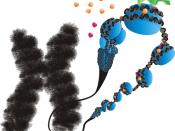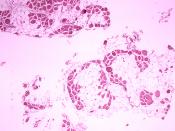The human genome is split into 23 pair's chromosomes (DNA), which are coiled in a spiral ladder type through nucleotide hydrogen bases (cytosine-c, guanine-g, thymine-t, adenine-a) (fig1 below). Human cells have 46 chromosomes (fig 2 below) - 22 pairs of autosomes chromosomes 1 to 22 and two sex chromosomes X and y or X and X depending gender (sex-linked). Within these chromosomes are roughly 30,000 genes that controls and construct the organs in the body.
There are over approximately 250 recognized sex-linked diseases, affecting every organ system. Of these, 95% affect males as it reflects the presence of the abnormal gene on the X chromosome, which is present in two copies in females and one in males. Males inherit the X chromosome from their mother and the Y chromosome from their father. Since this is the case, abnormalities on the X chromosome from the mother will usually manifest as a disease within 50% of her males offspring's.
Since females have a chromosomal make-up of XX, inheriting an X chromosome with disease mutations in it generally will not produce the disease condition. The healthy X chromosome that the female has inherited from her other parent male masks the diseased X chromosome. The female with one mutated X chromosome would be known as a carrier because she can pass the mutation onto her children, though she may not be directly affected by it. An X-linked disease could affect a female, in a lower percentage, if her mother is a carrier and the disease affects her father. If her mother and her father are both affected with the disease, she will most certainly be afflicted with the disease as well.
Despite these many sex-linked diseases, at present prenatal diagnosis can specifically be made in fewer than 40 diseases. These sex-linked diseases of single...



Very good
very good
1 out of 1 people found this comment useful.